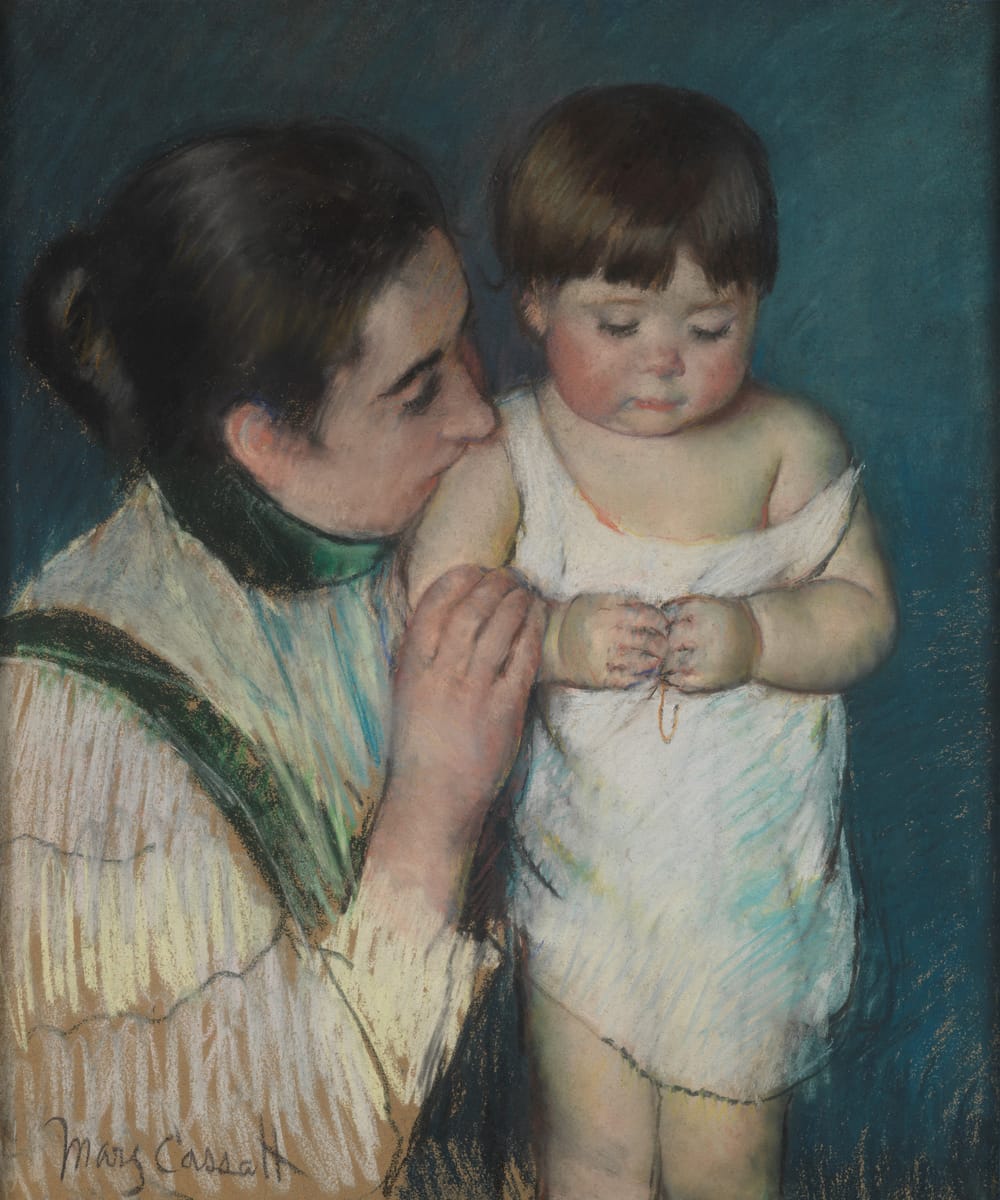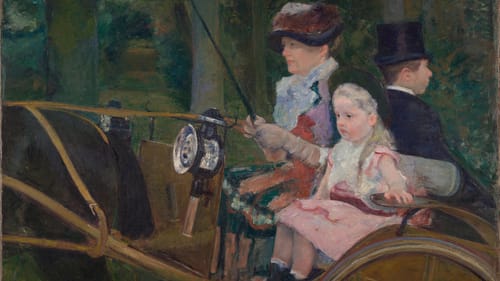Stay in the Loop
BSR publishes on a weekly schedule, with an email newsletter every Wednesday and Thursday morning. There’s no paywall, and subscribing is always free.
Meet the iconic Impressionist with a new exhibition and public virtual class
Philadelphia is spending summer 2024 with Mary Cassatt

This summer, local institutions are coming together to celebrate the art of an iconic Impressionist, Philadelphia’s own Mary Cassatt. It all centers on the Philadelphia Museum of Art’s Mary Cassatt at Work (May 18 to September 8, 2024), but also includes a new class from the Barnes and Cassatt-inspired treats at the Rittenhouse Hotel.
The exhibition encompasses about 130 pieces: 36 from the museum’s own collections and the remaining pieces on loan from other museums and private collections, including a rare sighting of PAFA’s Young Thomas and His Mother. For an up close and personal look at Cassatt’s work, the Barnes Foundation will be hosting an online class led by PMA curator of European painting and sculpture Jennifer Thompson and co-curator Laurel Garber. And you can share in the family connection with a luxury stay in the Cassatt Suite at the Rittenhouse Hotel, or sample one of her favorite sweets at the hotel’s Mary Cassatt Tea Room.
An honest eye
If you were a woman aspiring to a career as an artist in the 1800s, it helped to be a Philadelphian. PAFA was the first art school and museum in America and presented women artists from its first annual exhibition in 1811. Cassatt grew up here and attended the school in 1860 when, according to PAFA curator of historical American art Dr. Anna O. Marley, “any American artist worth their salt would study at PAFA.” Thomas Eakins was a year behind and Emily Sartain, a fellow student, later became the first woman director of the Philadelphia School of Design for Women (now the Moore College of Art).
Still, the market rejected women painting the popular historic subjects of the day; portraits and domestic scenes were deemed appropriate for them. Cassatt had too honest an eye for portraits, but she brought that honesty to the portrayals of women and children for which she is famous.
The identities of working women
Cassatt never let go of her Philadelphia roots, but Paris became her home and workplace, which put her art in Thompson’s bailiwick. The exhibit has taken years of effort that started with a common thread woven through the 180 family letters in the PMA’s collection. “She or her parents are always talking about, ‘Mary’s at the studio again,’ ‘Mary’s hard at work preparing for an exhibition,’” Thompson told me, “She’d say, ‘I work eight to 10 hours a day, you don’t understand the effort it is to paint.’”
A lot has been said about the wealth of the Cassatt family (her brother, Alexander, was president of the Pennsylvania Railroad), but by 1878, Cassatt’s sister and parents were living with her in Paris. Thompson paraphrases a letter from Cassatt’s father: “I have told Mary that her studio must pay for itself.” If she wanted to continue making art, she had to make the work pay. Thinking about what that meant to Cassatt, the museum embarked on a study of the 84 works by Cassatt in the collection. Most of those are prints, but it also has eight paintings and six pastels created over the course of her career, and Thompson said, “We became very attuned to seeing the work of her hands in all of these different media.”
They began to notice the hands in the art as well. The models, she said, were seamstresses and household staff. “These are all people that she brought together for these scenes which have such intimacy and familiarity. But she’s creating a fiction, using paid models. [Then] she breaks that fiction. She’ll sometimes put her models in silks and satins, but she’ll show them with reddened, work-worn hands.” Mary Cassatt at Work ties these threads together: the identity Cassatt builds as a working artist and her process creating her art tie back to the portrayals of women engaged in work themselves.
In a woman’s hands
Sometimes, the model was her sister, Lydia. Thompson points to the painting Driving, in which Lydia is driving a pony cart. “Her sister is seated in the front of the carriage, next to a girl named Odile, who is the niece of Edgar Degas.” Lydia holds the reins of the carriage, and Thompson said, “There’s a groom seated in the back, but she’s really made her sister’s hands, and their activity, the absolute center of the painting and is showing her sister as an independent woman.” In the painting we see just the rim of the wheel and the back end of Bichette the pony: “It’s almost as if you are seeing a film still in which the carriage is moving off to the left.”

Using x-ray radiographic images and infrared reflectogram technology to see below the surface, the museum reveals Cassatt’s process: she scraped off parts of earlier versions and painted over them, adjusting the wheel and moving a head-lamp and the groom. “Sometimes, she’s kind of scraping dry colors across one another,” Thompson said, “There’s a kind of staccato, broken quality to it, which helps to visually blend the colors and make them a bit velvety in appearance.”
Drafts and collectors
The artist Degas became Cassatt’s entrée into the world of the impressionists and piqued her interest in prints. An exhibition of Japanese woodblock prints in 1890, which she saw with Berthe Morisot, further inspired her series of 10 prints showing the everyday activities of women. The Bath was the first, and to prepare, she made drawings and at least 19 different proofs of the prints etched on a copper plate. Thomas said that “sometimes these prints, or drawings in particular, have thumbprints on them, they have stains; they’re working drafts.” The exhibition will present a wall of these drafts for two of the drawings: “Visitors will be able to see Cassatt literally at work, to see the stages of development of this print.”
Cassatt’s longstanding friendship with collector Louisine Havemeyer led to a later vocation as an influencer of her day, advising Havemeyer and others on their collections. Thompson explained that “she’s encouraging and supporting all of these collectors in the formation of their significant art collections, with the idea that they will one day come to US museums. Today, the Havemeyer collection is the core of the Impressionist collection at the Metropolitan Museum of Art.
Outside the museum
If you want to take the exhibition home with you, check out the 300-page catalog or take the four-week online class with Thompson and Gerber through the Barnes Foundation in June. According to Barnes deputy director for research, interpretation, and education Martha Lucy, the class will use high-resolution images to zoom in and out: “We’ll be able to get really close to the brush strokes, to the pencil marks.” Classes will be recorded, so students can keep them in their course library to view again later. The course will be easy to access: no software, downloads, or login needed; just click on the link they send.
Cassatt’s brother Alexander had his townhouse on the current site of the Rittenhouse Hotel, which will be celebrating the connection. The chocolates on the pillow in the Cassatt Suite will be the artist’s own recipe, and the hotel expects to offer them in its Mary Cassatt Tea Room. Or you can stop for a cocktail inspired by the colors in her paintings while checking out Cassatt’s prints in the lobby.
At top: Mary Cassatt’s 1893 Young Thomas and his Mother. Pastel on wove paper, 23 5/8 x 19 3⁄4 in. Courtesy of the Pennsylvania Academy of the Fine Arts, Philadelphia. Pennsylvania Academy purchase, 1904.10. This rarely exhibited painting will only be on display in Philadelphia and will not travel when the show moves to San Francisco.
What, When, Where
Mary Cassatt at Work. $35; free for PMA members. May 18 through September 8, 2024, at the Philadelphia Museum of Art, 2600 Benjamin Franklin Parkway, Philadelphia. (215) 763-8100 or philamuseum.org.
Mary Cassatt at Work online course. $220; $198 for members. Tuesdays, June 4 through June 25, 2024, 4-6pm, virtually through the Barnes Foundation. (215) 278-7000 or barnesfoundation.org.
Museum weekend packages, the Mary Cassatt Tea Room, and the Library Bar. Prices vary. The Rittenhouse Hotel, 210 W Rittenhouse Square, Philadelphia. (215) 546-9000 or rittenhousehotel.com.
Accessibility
The PMA is a wheelchair-accessible venue.
Sign up for our newsletter
All of the week's new articles, all in one place. Sign up for the free weekly BSR newsletters, and don't miss a conversation.

 Camille Bacon-Smith
Camille Bacon-Smith